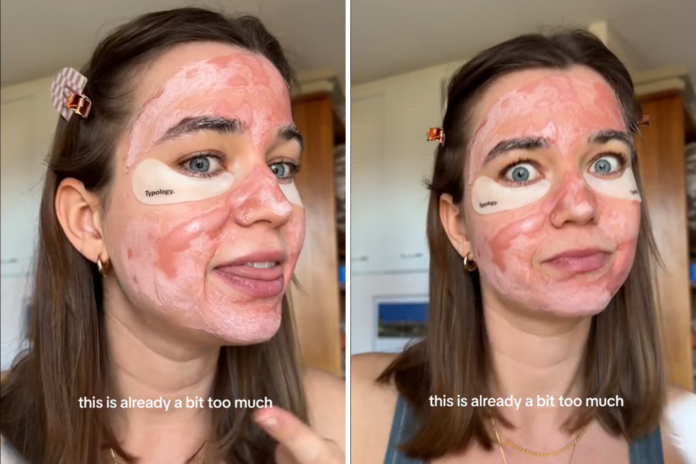Life’s little luxuries are what keep us going, and there is nothing more likely to help you relax than a pamper session from the comfort of your own home, completed with a face mask for the full DIY spa experience.
There are so many face masks on the market, so, whether you favor a 15-minute sheet mask or a more in-depth multi-step one, there truly is an option for every skin type and concern. One of the more popular formulations is the clay mask, great for drawing out impurities and boosting your skin, as long as you are using it correctly. Unfortunately, it turns out we have all been making an error when it comes to clay mask application, by letting it dry.
In a viral TikTok video, Eli Leimer, from Switzerland, took viewers through the importance of keeping the clay damp, explaining the reasons why you should “never let your clay mask dry.” Leimer said to the video’s 688,000 viewers that: “your skin is only going absorb the benefits of the clay when it’s damp. When it dries, it’s actually removing moisturize from your skin; it’s not removing impurities like I used to think for ages.”
To ensure her mask stays damp throughout the process, she sprays water onto her face when she feels it is getting too dry.
@holisticeli/TikTok
Leimer, who used to let the masks dry fully, told Newsweek: “I learned about this hack when seeing someone use steamer to lightly mist the face whilst doing a clay mask, which initially really surprised me as I thought the point of a clay mask is to fully let it dry out. I then did some research.
“When you use a clay face mask, the damp phase is when your skin is benefiting from all the minerals from the outside. When you get into the start of the drying phase, this pulls on your capillaries and stimulates blood flow as the mask cools and contracts on your skin, which is the funny, crackling feeling you start to get.
“After that, is the dry phase, which we want to avoid as it removes out moisture from the surface of your skin, causing dehydration and irritation. Many people with oily skin mistake the moisture drying as their oils, but even with oily skin, you do not want to be removing moisture. The end goal is to balance sebum production.”
Aesthetic and medical doctor Dr. Brendan Khong, skincare expert at London’s Dr. David Jack Clinic, told Newsweek that clay masks can be a great addition to your skincare routine, as long as you are using them correctly.
“The tip is definitely true, and something that I have been doing on my own skin when using clay masks,” Khong said.
“Clay masks that dry on the skin can disrupt the skin’s delicate moisture barrier and overly dehydrate the skin. For oilier skin types, the temptation is to leave clay masks to dry completely, often until they have ‘cracked’, to try to dry up the excess sebum.
“However, when too much sebum and moisture are removed, which signals your sebaceous glands to produce even more sebum, resulting in even oilier skin. Leaving clay masks on to dry completely can drive this vicious cycle,” Khong added.
For those worried about overdrying out their skin with the mask, Khong recommended spot treating instead of applying the product to your whole face. He said that you should “use the clay mask only on areas which need it, typically in the T-zone, beside the nose and chin, or areas which are prone to breakouts.
“I always recommend patients to remove masks with a clean, damp cotton washcloth. Splashing water to rinse off might not always effectively remove the residue of the mask. I would also recommend using a light hydrating mask after to flood the skin with moisture, to keep the skin a beautiful, hydrated glow,” Khong added.
What Do the Comments Say?
Clay mask fans were shocked by Leimer’s video, with many unaware that the mask shouldn’t be allowed to dry fully.
One user commented: “Really? I was thinking it was the other way around. The more dry the better.”
Another added: “omg [Oh my god] I wish I knew this an hour ago – I waited like 45 mins until the clay dried on my cheeks.”
A third posted: “I always let it dry – like fully until it flakes off. Good to know lol [laugh out loud].”
Others were cautious of Leimer’s advice, as one added: “If we’re not supposed to let it dry then why it’s in instructions?”
Another wrote: “The tightening of some clay masks can actually be beneficial to boost circulation to the face but, yes, it can be drying, so it’s important to hydrate afterwards and be cautious with dry skin types.”
Uncommon Knowledge
Newsweek is committed to challenging conventional wisdom and finding connections in the search for common ground.
Newsweek is committed to challenging conventional wisdom and finding connections in the search for common ground.


